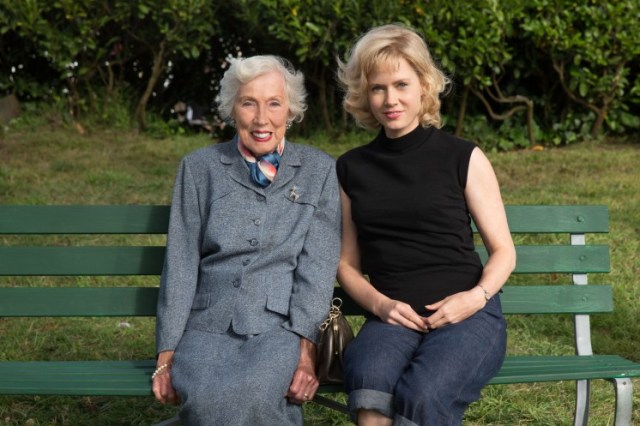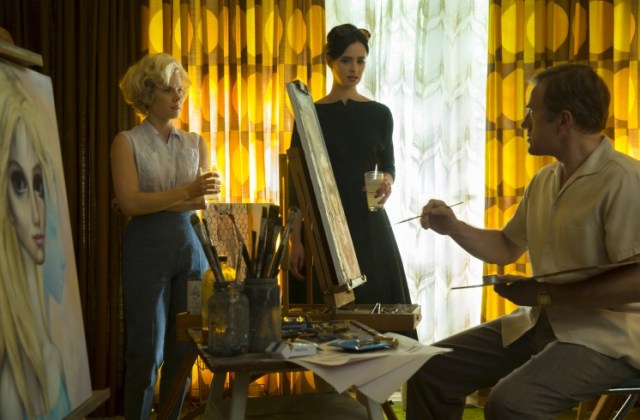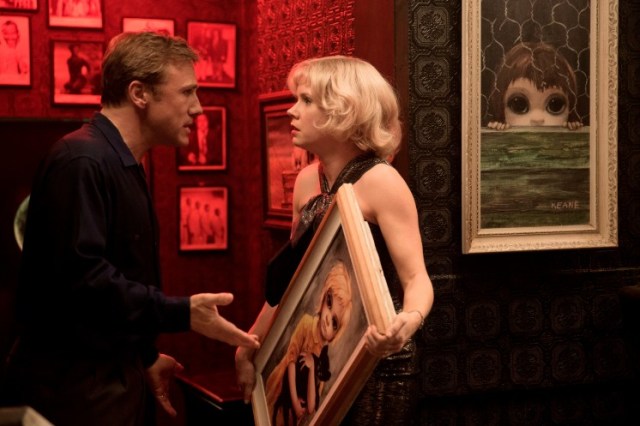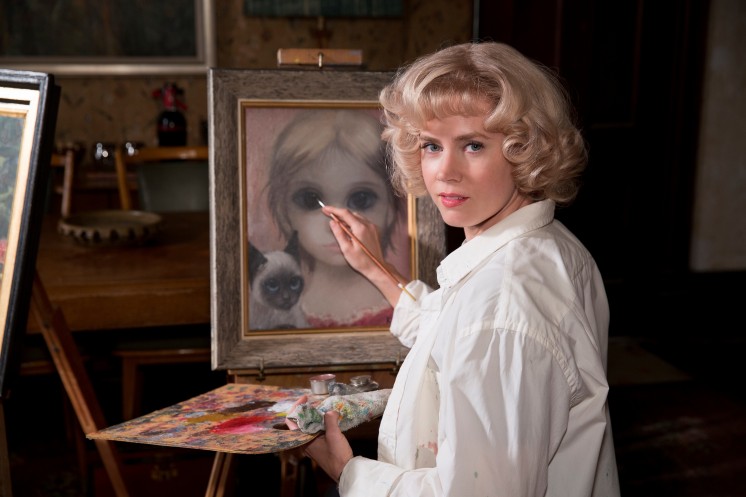Scott Alexander and Larry Karaszewski are two of the most innovative writers of biopics in the business today. They have written about the life of Ed Wood (Ed Wood), Bob Crane (Auto Focus), Larry Flint (The People Vs Larry Flint), Andy Kaufman (Man in the Moon), and now the marriage of Margaret and Walter Keane. Big Eyes stars Amy Adams, Christoph Waltz, Krysten Ritter, Jason Schwartzman, Danny Huston, and Terence Stamp, and is the second collaboration for Alexander and Karaszewski with director Tim Burton (who previously directed Ed Wood). The twosome discovered the story of one of the biggest art frauds ever perpetrated, and reached out to artist Margaret Keane, eager to tell her story. What they found, besides the hilarious and thrilling story of the stranger-than-fiction con, was a deeper story of a woman who lost her sense of self in marriage, but found redemption when she took back her name and declared ownership of her remarkable artwork.
Lesley Coffin (TMS): I wanted to ask you about Margaret’s daughter Jane, who starts out the film as a little girl and really Margaret’s moral compass. Jane seems to be the reason Margaret feels such guilt over the lies she’s been telling to the public, and the person who really convinced Margaret to come forward. Did you get an opportunity to meet her?
Scott Alexander: When we first met Margaret, we had already done a lot of research, but it all came from old magazines.
Larry Karaszewski: All very Walter-centric because of when they were written.
Alexander: So we knew only the bare minimum, and there was almost nothing about Jane. She would appear in the background of a few pictures with Margaret and Walter as a photo op. But there was nothing about her. Then when we met Margaret, Jane came with and we found out they live together, always have. And Jane came to the lunch briefly to say hello, and then left. And as Margaret started talking, she talk a lot about Jane and what it was like for her to grow up in that kind of household with Walter. It was the three of them living in the house together, she was 8 or 9 when this all started, and Jane isn’t stupid. She knew momma was in the back room painting all day, she knew Walter wasn’t, but every night Walter walks out of the house with a new painting. So she knew, she had to have known. And Jane, like any kid, would say, “But you’re the painter,” and Margaret would tell her, “No, I’m not, and don’t say that to anyone else.” Jane knew Margaret was lying to her and that was what was killing Margaret. Jane was the only person she was close to at this time, because Walter had forced her to cut all the ties she had to friends. So when Margaret would talk to us about all these regrets she had, they were almost always about Jane. She was the person she was closest to who she was lying to the most.
Karaszewski: And the second Margaret said that to us, we knew, that was the heart of the story.
TMS: You can see the seeds of resentment and frustration growing in her daughter as she watches her mother stay silent.
Karaszewski: That is what happens to so many teenagers who grow up in those kind of households. At a certain point they realize what is going on is wrong. As kids we idolize our parents, but then as teenagers, they realize “my dad drinks too much,” and you have to break yourself away from your parents. And we didn’t do much of that in the film, but we certainly touched on it.
TMS: You mentioned that she didn’t have any friends at a certain point…
Karaszewski: Yes, and I think I know where you’re going with this question. That realization came out of our conversations with Margaret. We would ask, what about your support system, didn’t your friends try to help you?
Alexander: Obviously your friends knew this was going on.
Karaszewski: And she told us she had friends when this first started, “But I wasn’t comfortable lying to them, so I would cancel lunch and not see them for a year. And if someone came over they would get into a fight with Walter and it became easier not to have friends.” And she became a completely isolated person, particularly when Walter moved her out of the city. And when she told us that we knew we needed a character to represent that part of her life. So Krysten Ritter’s character isn’t based on one specific person, but an amalgam of all those friends Margaret lost or had pushed away.
TMS: You do touch on a lot of these big ideas which come up again and again in stories of life for women in post-war America, and this story just happens to be about a painter –
Alexander: It happens to be multi-million dollar art fraud.
TMS: But she is representative of life for a lot of women in the ’50s who felt like they had just been shut away in these suburban hells.
Alexander: My mom stayed with [my] dad for 20 years, and it was a terrible relationship. It wasn’t violent, but it was certainly emotionally abusive. And she stayed because she was [a] catholic girl who couldn’t get divorced. But finally, she couldn’t take it one day, she threw us in the back of the car, and just left. That isn’t Margaret Keane’s story, but I could definitely feel the similarities.

TMS: Is that part of what drew you to the story initially?
Alexander: The big, initial interest was the story of these two opposing characters and this crazy art fraud. But the more we spoke to Margaret, the more we saw this as an empowerment story and came to see this story as a metaphor for a larger idea. It was the story of a woman coming out of ’50s suburbia, where it was a man’s world and women had to just stand behind their husbands and let men speak for them. The running joke we had was every single time we would try to get this movie made, our line producer wanted to remove the opening shot of the suburbs, because it is a really expensive shot for a five second scene. You are asking an art crew to build an entire block for five seconds, that isn’t cost effective. But it was so important to us to have that shot in the movie because that is what grounds the movie and tells the audience, this is the life Margaret is coming out of and by the time the movie is ending, it is the late ’60s and women’s lib is just starting to bubble up in the background. And that was when Margaret found the confidence to speak up.
TMS: When it came to creating that image of the suburbs and the house she had with her first husband, along with the narration, what were you trying to tell the audience in those first moments on screen?
Karaszewski: Well, you need to put them in the right mindset. A lot of girls today don’t really think about the fact that women had so few options back then. So we thought by opening the movie and telling them what life was like for Margaret back then, they would get the fact right away, this is not a modern woman, and even though this is less than 50 years [ago], there has been a major shift in that time.
Alexander: Also, Margaret is such an extreme version of the story of women from that time. That is why we choose to make a movie about her. At times it almost seems like science fiction. People will say, she didn’t really stay with him for 10 years. 10 years is a really long time considering what happened. So we wanted the audience to know, this was possible, and this did happen.
TMS: Was there ever a version of the story when you considered telling the story of Margaret’s first marriage as well?
Karaszewski: No, because there was so much about her marriage to Walter we wanted to tell, we didn’t have time. That is the trick to writing about a person’s life. It can’t be about everything so you really have to pick and choose carefully.
Alexander: And in terms of writing short hand, we have a scene of Amy running around the house, figuring out what she wants to keep. She takes down a painting, takes down a painting, looks at her wedding picture and leaves it. That was really all we needed to know.
TMS: There is so much in the movie about the art work. What are your personal feelings about the Big Eyes paintings?
Karaszewski: They are fascinating pieces, but part of the reason they were always considered kitsch was because they seemed to have no personality behind them. When you thought it was Walter Keane, this big muscular man, painting pictures of big eyed children and kittens, it made no sense. But when you know the art is by a woman in pain, the art takes on an emotional meaning it might not have had before. And I hope that is one of the things this movie is able to do; make people look at the paintings a different way and see that they weren’t just commercial paintings but works that meant something to Margaret and to see the sincerity behind them.
TMS: The image of the suburbs the film has is very reminiscent of the version of the suburbs created by Tim (Burton) in Edward Scissorhands.
Alexander: That was funny, because even before Tim was attached to direct, we thought about the suburbs the same way. As sort of this cookie cutter trap we wanted to place Margaret in. And Tim had done such a great job in Edward Scissorhands, it was certainly an influence for us.
Karaszewski: Our version was that the film would be a quick, brushstroke gender commentary about the time. We wanted to quickly show post world-war housing which had been built for the men coming home, going to jobs, and leaving their wives to just have babies. And Margaret comes out of that world and feels she can’t speak up for herself of step-forward. When Tim was doing Edward Scissorhands, it was commentary on bland conformity.
TMS: I really can’t imagine, having seen the film, any other director approaching the material with the kind of visual technique [Burton] did with this film. Developing the film, did you initially approach him to direct the movie?
Karaszewski: He was the only director we approached. There had been a time that we considered directing the film ourselves. And we had Tim attached to produce. But then he had an opening in his schedule, and Christoph was circling the role and really wanted to work with Tim. But I think for those reasons you mentioned, we knew Tim would get the material. And being a visual artist and painter himself, we knew he would bring some of himself to the story of Margaret Keane. Tim is famously non-verbal and this is literally the story of a woman who wasn’t allowed to talk. She had to put all her emotions into her art work and that is the same with Tim. And Tim is able to use the frame to tell things which aren’t being overtly stated. There are certain moments in the film when he tells a lot in the frame like no other director would have thought to.
Alexander: Something Tim cooked up, which never crossed our minds in all the years we were working on the film, was to use the swimming pool at night to visualize the characters emotions. It was really clever visual storytelling, because it was important to us to have a mid-century modern house with a lot of glass and a California swimming pool. For us the imagery was to see Margaret as a caged bird who, despite having lots of money and seemingly being on top of the world, is trapped in this beautiful place. She is in a beautiful glass house surrounded by green but not a part of it. But what Tim realized was he could use the swimming pool to bounce colored lights and bounce them back onto the walls and faces of the characters during the second act when things start to spin out of control. It is what a good director does, they find a way to visualize and externalize internal emotions of characters.

TMS: And it is so subtle that, even though you know those moments are working and the images are striking, you don’t know why while you’re watching it.
Karaszewski: That is the key to visual storytelling. You almost shouldn’t notice it. If you notice while watching a movie a beautiful shot or the cinematography, you are being pulled out of the film. What Tim is so good at was creating a visual picture that makes you feel a certain way, without being told explicitly how to feel.
TMS: One of the key themes of the film is a big issue which all artists have to ask themselves, which is where do commerce and art intersect, and what is a signature style compared to having a gimmick.
Karaszewski: What happened with the Big Eyes paintings was they started out as sincere works of art, many of her own daughter. And initially, she was very excited when they started to sell. But once Walter started to put his name on them, it became almost like a factory, having to pump out paintings at such a rate. And that was when sadness really entered the paintings, and the children seem much sadder than before. Margaret was smuggling these emotions into popular art. But at times, simply because of the rate, there are better Big Eyes and worse Big Eyes. I find her second style, the NDH style, those are almost completely divorced for commercial consideration, so they have a very personal statement about womanhood that the Big Eyes children do not.
TMS: When speaking with Margaret, did you ask her if that second style would have come about had she been able to sign her own name to the Big Eyed paintings?
Alexander: That’s a great question. I’m not sure it ever crossed our minds? It never came up, but I think it’s a valid observation.
Karaszewski: I think it’s a great observation. It might not have come about because she wouldn’t have been forced to develop it. But she also might have naturally developed that second style organically.
Alexander: I think it’s interesting, because had she not been in this perverse, trapped situation, she wouldn’t have been forced to develop a completely different style.
Karaszewski: But Picasso had a second style, the blue period. But that is what an artist does, they take what is happening in their life and reflect it back in their art. Margaret’s art was being co-opted so she was forced to find a type of art she could claim as her own to express herself.
Alexander: But it is pretty unusual for an artist to be as bifurcated as she was. She was painting under two completely different styles simultaneously
Karaszewski: It’s almost schizophrenic. It’s kind of like us when we were writing Ed Wood at the same time that we were working on the remake of That Darn Cat.
TMS: There is this unfortunate tradition of screenwriters not getting recognized, or as much recognition as their director or actors. Did you identify with the idea of wanting to get the credit for your work?
Karaszewski: Thart question is excellent, it’s making realize I don’t ask enough questions about my own life. Scott and I have been so fortunate in our careers, especially with our biographical films. We’ve been singled out a number of times, and we are so fortunate because of it. But it is certainly true that writers have experienced directors or actors getting credited for lines which were in the script. And that is certainly a Margaret and Walter Keane kind of thing.
Alexander: But to answer the question directly about ourselves, I don’t think it ever crossed our minds.
TMS: What drew you to writing biographical films?
Alexander: We weren’t drawn to them initially, but Larry and I were feeling very beat up after The Problem Child movie because we hadn’t set out to make big, loud, trashy comedies, they just turned out that way. You never set out to make a movie that gets bad reviews, and we were sitting around talking about Ed Wood, whose films had just been a mockery. And we thought, what if people stopped making fun of him? What if we were to celebrate him and what he accomplished? He dreamed of being a Hollywood director and he made half a dozen films. So lets just celebrate the good and not criticize the bad. And the movie had an odd mix of comedy and drama, tragedy and weirdness, and people really responded to the script and said, do you have any others? And we said, we’ve always been interested in the life of Larry Flint. And one thing led to another. We could kind of write anything we wanted and we were never fired or replaced, and we were treated with respect. And we were very proud of the results. We also happened to enjoy the research.
Karaszewski: And we found that because we do so much research on the subject, we are the historians on the film. Scott mentioned we’ve never been replaced. Part of that is because we know where all the bodies are buried, we know all the facts. So it’s allowed us to be more a part of the production. We are producers on Big Eyes, but even on some of the other films, we have been more involved than screenwriters usually are. We had relationships with real people and would meet with the production and costume designers to give input and show them what the real people looked and dressed like and how they lived.
TMS: One of the common themes in a number of your films are characters who have this incredible ability to market themselves, which is a skill we really have begrudging respect for in society. Is that a characteristic which interests and attracts you to subjects?
Alexander: They are characters with this love of self promotion and are all trying to selling a very strange product, and really have to overcompensate. We are endlessly amused by characters who have the ability to endlessly talk about themselves, especially a number of people we’ve written about who love to talk about themselves in the third person which we find even more entertaining. It takes a lot of hubris to do that. They are businessmen, they are salesmen. And people are always coming to us to pitch potential subjects, and the most common pitch we get is to tell the story of Ron Popeil, the founder of the Showtime Rotisserie and spray-on hair and pocket fisherman. And maybe at the end of the end of the day, he is definition of the type of people we love to write about. He will just go on TV and talk about himself for thirty minutes, talking about how great he is and selling how great his product is.
Karaszewski: But the crazy thing about Walter Keane was the fact that he is our first character like that who is our antagonist, rather than our protagonist. But he’s an interesting bad guy because he’s really good at what he does. He is an amazing business man and able to accomplish so much with Margaret’s artwork. He’s a liar and a conman, but he is also an excellent businessman.

TMS: In your conversations with Margaret, what are her feelings towards Walter today, since his death?
Karaszewski: She has a lot of horrible memories of Walter, but she is also quite vocal about not defending him, but acknowledging that without him, her art would have gone nowhere. And she also feels a bit regretful for allowing the lie to take place and she doesn’t blame Walter 100%. She feels that had she stood up and not allowed him to do it, the whole thing would have turned out differently. And a lot comes from Margaret just being a really good person with very deep beliefs who is unwilling to blame it all on Walter. It is hard for her to revisit that time, especially in this film, but she also takes responsibility for her role in the lie.
TMS: Thank you both so much for your time.
Karaszewski: It was a pleasure!
Alexander: Thank you!
Lesley Coffin is a New York transplant from the midwest. She is the New York-based writer/podcast editor for Filmoria and film contributor at The Interrobang. When not doing that, she’s writing books on classic Hollywood, including Lew Ayres: Hollywood’s Conscientious Objector and her new book Hitchcock’s Stars: Alfred Hitchcock and the Hollywood Studio System.
Are you following The Mary Sue on Twitter, Facebook, Tumblr, Pinterest, & Google +?








